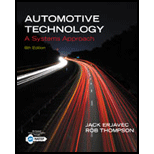
Automotive Technology: A Systems Approach (MindTap Course List)
6th Edition
ISBN: 9781133612315
Author: Jack Erjavec, Rob Thompson
Publisher: Cengage Learning
expand_more
expand_more
format_list_bulleted
Concept explainers
Textbook Question
Chapter 51, Problem 6RQ
In a typical drum brake, which component provides a foundation for the brake shoes and associated hardware?
- Wheel cylinder
Expert Solution & Answer
Trending nowThis is a popular solution!

Students have asked these similar questions
In a typical drum brake, which component provides afoundation for the brake shoes and associatedhardware?a. Wheel cylinderb. Drumc. Backing plated. Lining
Duo-servo drum brakes are also known as what type of brake assembly?
Which of the following statements about drum
brake shoes is not true?
a. Linings may be riveted or bonded to the shoes.
b. Shoe indentions hold the shoe in place
against the backing plate.
c. The shoe rim supports the shoe lining.
d. The primary/leading shoe is typically the one
that is positioned toward the front of the
vehicle.
Chapter 51 Solutions
Automotive Technology: A Systems Approach (MindTap Course List)
Ch. 51 - Name the two methods of attaching brake lining...Ch. 51 - Explain how drum brakes create a self-multiplying...Ch. 51 - List at least five separate types of wear and...Ch. 51 - What is the job of wheel cylinder stops?Ch. 51 - Explain the operation of an integral drum brake...Ch. 51 - In a typical drum brake, which component provides...Ch. 51 - True or False? The name duo-servo drum brake is...Ch. 51 - Prob. 8RQCh. 51 - Which of the following statements about drum brake...Ch. 51 - Brake linings should be replaced when. linings are...
Ch. 51 - In the unapplied position, drum brake shoes arc...Ch. 51 - Duo-servo drum brakes are also known as what type...Ch. 51 - On most vehicles, the automatic adjuster cables or...Ch. 51 - Backing plates, struts, levers, and other metal...Ch. 51 - A buildup of brake dust and dirt between the...Ch. 51 - Technician A says that an out-of-round drum can...Ch. 51 - Technician A says that a grinding noise from a...Ch. 51 - It has been determined that chatter and brake pull...Ch. 51 - Technician A says that the discard dimension of a...Ch. 51 - After resurfacing a brake drum: Technician A...Ch. 51 - Drum linings are badly worn at their heel and toe:...Ch. 51 - When machining brake drums: Technician A tries to...Ch. 51 - While discussing what would happen if too much...Ch. 51 - Technician A checks the surface of the drum for...Ch. 51 - While discussing pull during braking: Technician A...
Knowledge Booster
Learn more about
Need a deep-dive on the concept behind this application? Look no further. Learn more about this topic, mechanical-engineering and related others by exploring similar questions and additional content below.Similar questions
- The basic frictional parts of a brake system are being discussed: Technician A says that the harder the frictional parts are pushed together, the higher the friction. Technician B says that the harder the frictional parts are pushed together, the more heat is developed. Who is correct? Technician A only Technician B only Both A and B Neither A nor Barrow_forwardTrue or False? The name duo-servo drum brake is derived from the fact that the self-energizing force is transferred from one shoe to another with the wheel rotating forward.arrow_forwardTrue or False? The name duo-servo drum brake isderived from the fact that the self-energizing force istransferred from one shoe to another with the wheelrotating forward.arrow_forward
- Which type of brake requires greater application force and is commonly used with power-boost units? Drum Disc Parking None of the abovearrow_forwardWhich of the following statements about drum brake shoes is not true? Web thickness varies only with changes in shoe size. Many shoes have indented places along the edge of the rim. The shoe rim is welded to the web. The primary/leading shoe is typically the one that is positioned toward the front of the vehicle.arrow_forwardWhen machining brake drums: Technician A tries to remove only enough metal to obtain a true, smooth surface. Technician B cuts the drum on the other side of the axle to the same diameter as the one that was cut first. Who is correct? Technician A only Technician B only Both A and B Neither A nor Barrow_forward
- Technician A says that a grinding noise from a drum brake when it is not applied can be caused by a bad wheel bearing. Technician B says that a grinding noise from a drum brake when it is not applied can be caused by worn brake hardware. Who is correct? Technician A only Technician B only Both A and B Neither A nor Barrow_forwardWhile discussing quick take-up master cylinders: Technician A says that this design allows for increased braking power. Technician B says that this design is only used on drum brake systems. Who is correct? Technician A only Technician B only Both A and B Neither A nor Barrow_forwardTechnician A says that the discard dimension of a brake drum is the drums allowable machining dimension. Technician B says that the discard dimension is the allowable wear dimension. There must be 0.030 inch left for wear after machining. Who is correct? Technician A only Technician B only Both A and B Neither A nor Barrow_forward
- True or False? Backing plates, struts, levers, and other metal brake parts should be cleaned with a wet-cleaned using water or a water-based solution.arrow_forwardWhen replacing brake pads on a vehicle: Technician A works on one wheel before beginning work on an-other. Technician B uses a minimum of 52 psi of air pressure to force the piston from the caliper housing. Who is correct?arrow_forwardWhich type of brake requires greater application forceand is commonly used with power-boost units?a. Drumb. Discc. Parkingd. None of the abovearrow_forward
arrow_back_ios
SEE MORE QUESTIONS
arrow_forward_ios
Recommended textbooks for you
 Automotive Technology: A Systems Approach (MindTa...Mechanical EngineeringISBN:9781133612315Author:Jack Erjavec, Rob ThompsonPublisher:Cengage Learning
Automotive Technology: A Systems Approach (MindTa...Mechanical EngineeringISBN:9781133612315Author:Jack Erjavec, Rob ThompsonPublisher:Cengage Learning Automotive TechnologyMechanical EngineeringISBN:9781337794213Author:ERJAVEC, Jack.Publisher:Cengage,
Automotive TechnologyMechanical EngineeringISBN:9781337794213Author:ERJAVEC, Jack.Publisher:Cengage,

Automotive Technology: A Systems Approach (MindTa...
Mechanical Engineering
ISBN:9781133612315
Author:Jack Erjavec, Rob Thompson
Publisher:Cengage Learning

Automotive Technology
Mechanical Engineering
ISBN:9781337794213
Author:ERJAVEC, Jack.
Publisher:Cengage,
Mechanical Design (Machine Design) Clutches, Brakes and Flywheels Intro (S20 ME470 Class 15); Author: Professor Ted Diehl;https://www.youtube.com/watch?v=eMvbePrsT34;License: Standard Youtube License